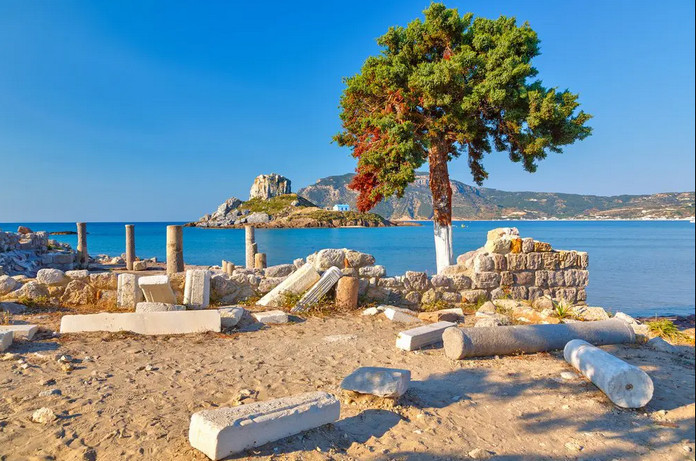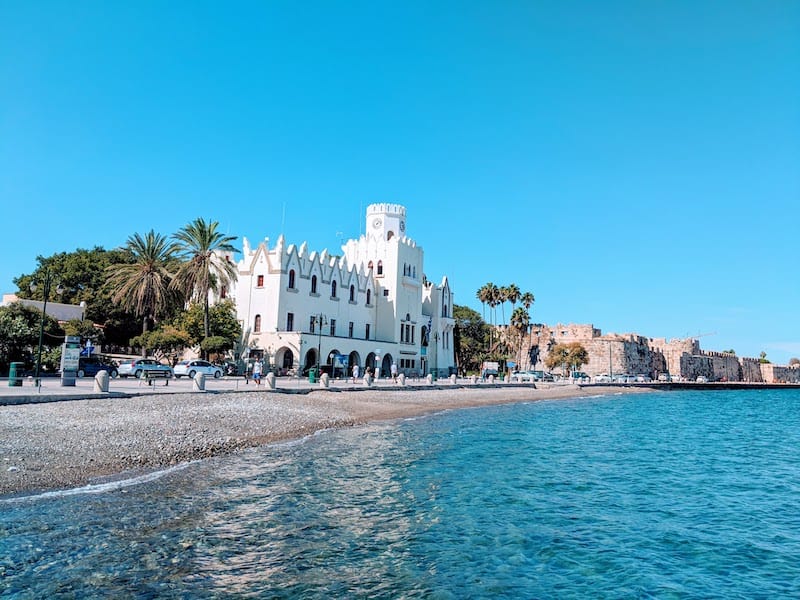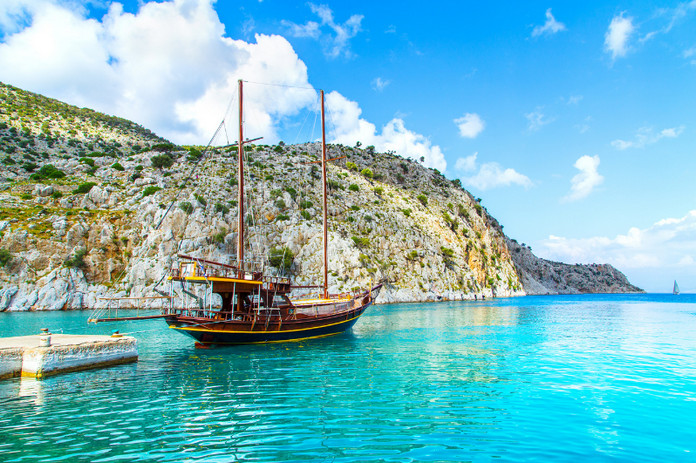The beautiful town of Kos, the capital of the island is built in a verdant area at the north-east end of the island. Palm trees grow at the sides of the streets, which are full of bicycles, a mode of transport very popular with the inhabitants.
It is a modern town with a carefully laid out urban design and street plan, some fine squares, modern buildings, wide streets, many hotels, etc. There are some great beaches around the town: Meropida, Psalidi, Ayios Phokas, Dimitra, Lambi, and Pharos.

At Thermes, 1km southwest of Ayios Phokas there are mineral springs, with facilities and baths. Archaeological excavations on the site of the ancient city have revealed foundations of ancient buildings, the building of the Hellenistic and Roman periods, sections of a Classical fortification wall, and the remains of 2 temples (one of Aphrodite and the other dedicated to Herakles).
The sites in the city worth seeing include:
– the plane tree of Hippokrates (it is thought to be the oldest tree in Europe and is believed to be planted by Hippokrates himself.
– the Venetian castle of the Knights of St. John is in a good state of preservation and is a striking example of the defensive architecture of the period.
– the Loggia, a two-story 18th-century building with a tall minaret built of the material taken from the area of the ancient city
There are some interesting Early Christian churches both inside and outside the town: the basilica of Ayios Ioannis and the churches of Agios Nikitas o Phtokos, Ayia Ekaterini, the Panayia Syndriani, and the Panayia Tsoukalaria, all of which have some notable wall paintings and finely carved iconostases.

The Archaeological Museum in the townhouses finds of Classical, Hellenistic, and Roman times, amongst them a statue of Hippokrates.
The Asklepion lies 4km outside the town in an area overlooking the sea.
Building work on it began after the death of Hippokrates. Because of the sloping nature of the ground, the buildings in the sanctuary are set on three different terraces connected by a grand staircase.
The first terrace was a kind of a courtyard, surrounded by stoas in which various events took place and in which the medical school was also housed.
The main building on the second terrace was an altar. Two restored columns belong to the 3rd-century temple of Asklepios. The highest terrace is dominated by the 2nd-century temple of Asklepios, a Doric peripteral temple surrounded by a Hellenistic stoa. In this area, there are also traces of the rooms occupied by the sick.
The island of Kos has many villages in superb natural settings: Asphendou lies in the foothill of Mount Dikalos, Tingaki is a coastal settlement opposite the small island of Pserimos, Pyli extends over a plan with the ruins of a Byzantine castle, Andimakhea is built on a plateau on which is the island’s airport.

Kephalos is in the southwest of the island in an area that contains a large number of monuments. It is a traditional settlement with a long history since it is here that the ancient capital of the island was located. In Kephalos there is a traditional house that functions as a folklore museum.
There are several cultural events on Kos. The Hippokratea is a festival held in August that includes exhibitions, performances of plays, displays of dancing, and concerts. In the Asklepion, there is a re-enactment of the swearing of the Hippocratic oath every Sunday afternoon. The International Hippocratic Foundation of Kos also organizes important medical conferences.
How to get there:
There are flights from Kos to Athens and Rhodes. The airport is 27km away from Kos town. Kos is linked by ferry with Piraeus. There are also ferry connections between Kos and the rest of the Dodecanese. some of the islands in the Cyclades, the East Aegean Islands, and Thessaloniki. From Kardamena and Kephalos there are daily services to Nisyros. Many tourist boats also make excursions to Nisyros, Pserimos, and Kalymnos during the summer months. There is a hydrofoil service to several of the islands in the Dodecanese and East Aegean.